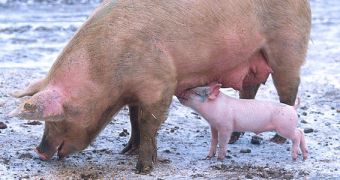Much to the surprise of researchers at the United States Department of Agriculture (USDA), pigs are apparently capable of allowing bacteria inside them to become antibiotic-resistant in less than two weeks. At this rate, the microorganisms can out-pace anything we throw at them.
It takes a very long time for researchers to come up with a new class of drugs to kill resistant bacteria, but if they can jump species and gain new immunities in just two weeks, then our efforts are doomed to fail. This issue is very important, since many people die due to hospital-acquired, antibiotic-resistant bacterial infections.
Experts with the USDA Agricultural Research Service's National Animal Disease Center in Ames, Iowa, determined that the particular strain of Escherichia coli which they detected in pigs was in no way harmful to either species, LiveScience reports.
“We wouldn't have been surprised that bacteria shift populations or that resistance genes changed. We were a little surprised by how much E. coli populations went up in the medicated group,” says Thad Stanton, who is a microbiologist at the Center.

 14 DAY TRIAL //
14 DAY TRIAL //